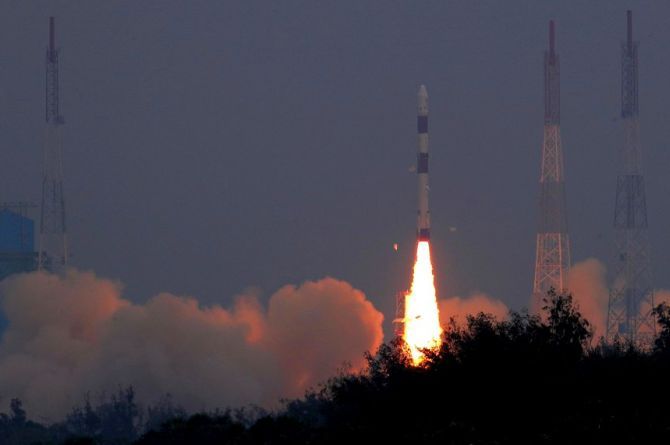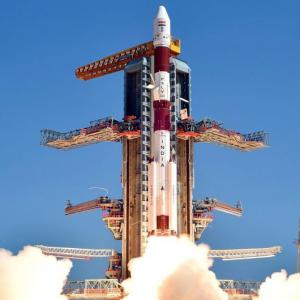India on Thursday successfully launched its latest earth observation satellite Hyper Spectral Imaging Satellite, the data from which can be used in wide-ranging areas including agriculture, from the Satish Dhawan Space Centre onboard India Space Research Organisation’s trusted workhorse Polar Satellite Launch Vehicle.

The rocket, PSLV-C43, successfully injected state of the art HysIS and 30 other co-passenger satellites from eight countries into their designated orbits.
The rocket lifted off majestically into cloudy skies in a burst of orange flames at 9.57 am from the first launch pad at this spaceport at the end of the 28-hour countdown.
The HysIS was placed in its orbit 17 minutes and 27 seconds after lift-off while the 30 co-passenger satellites were dropped into the designated orbit one by one after an hour.
HysIS, the latest earth observation satellite developed by ISRO, has several uses.
The satellite’s data will be useful in many fields including agriculture, forestry, soil survey, geology, coastal zone studies, inland water studies, environmental monitoring and pollution detection from industries.
ISRO chief K Sivan and the space agency’s scientists broke into cheers as the earth observation satellite was injected into sun-synchronous polar orbit.
Thursday’s launch is significant as scientists restarted the fourth stage engine twice to place the 30 co-passenger satellites into their orbit.
According to an official, the fourth stage engine was cut off after the earth observation satellite separated at an altitude of 636.3 kilometres exactly 17.27 minutes after the rocket lifted off.
After the earth observation satellite was placed in its orbit, the scientists undertook an operation to restart the fourth stage engine twice. They reduced the altitude from 636 kilometers to around 504 kilometres to place the 30 satellites in the sun-synchronous polar orbit one by one.
The mission was one of the longest for ISRO.
A similar campaign was undertaken when scientists injected eight different satellites including the country’s weather satellite SCATSAT-1 and five from other nations in two different orbits on September 25, 2016.
The primary mission of the HysIS, whose mission life is five years, is to study the earth’s surface in visible, near infrared and shortwave infrared regions of the electromagnetic spectrum.
It is the primary satellite of the PSLV-C43 mission, which is on its 45th flight.
The mass of the spacecraft is about 380 kilogram, ISRO said.
The co-passenger satellites have been contracted for launch through ISRO’s commercial arm Antrix Corporation Limited.
PSLV-C43 is the ‘Core Alone’ version of PSLV. It is the lightest version of the launch vehicle.
Sivan congratulated the team on the successful launch and said Indian scientists have shown their excellent work yet again, just 15 days after the spectacular dual mission of GSLV MkIII D2 and GSAT29.
“Today our PSLV has injected hyperspectral imaging satellite and subsequently after two manoeuvres, once again PSLV has injected 30 customer satellites into their designated home,” he said.
Speaking about the high-tech hyperspectral satellite, Sivan said it came with state-of-the-art technology.
“The heart of the system required for the HysIS satellite is basically an optical imaging detector chip,” he said.
The chip was indigenously designed and developed by the space application centre of ISRO and fabricated indigenously at the semiconductor lab in Chandigarh, he added.
“I am sure that team ISRO can be proud that they are really giving excellent space assets to India. Let me thank the entire team ISRO for this wonderful satellite (launch),” Sivan said.
He said the international customers will be very happy to see their “babies” delivered home “safely and precisely”, one by one.
The space body chief said the success was a result of team ISRO’s hard work along with excellent mechanisms and the quality system in place.
“Looking forward, our journey ahead, road ahead, is full of traffic,” Sivan said.
The next mission will be GSAT11, which is India’s heaviest satellite. It is set to be launched from French Guiana on December 5 at 2.08 am.
The long-awaited launch of GSAT-7A is also planned for December.
Sivan said several missions including Chandrayaan-II are lined up for next year.
“I am sure this team will rise to the occasion and will achieve (in) the missions whatever we want, not for ISRO, it is for India. I am sure that our team will do (a) very good job in future also,” he said.










